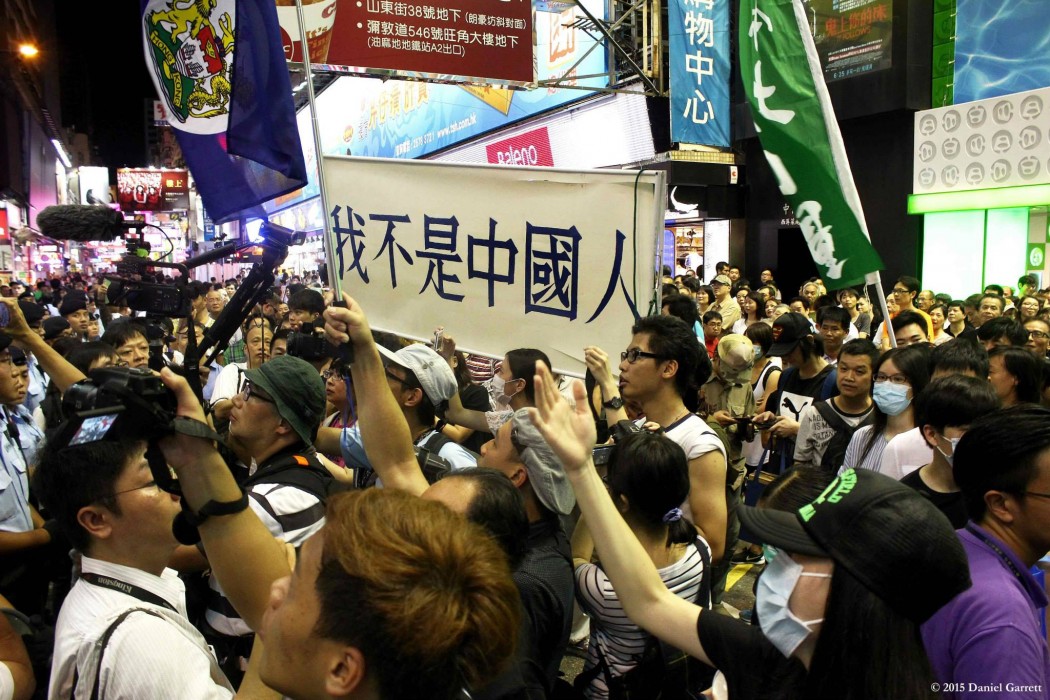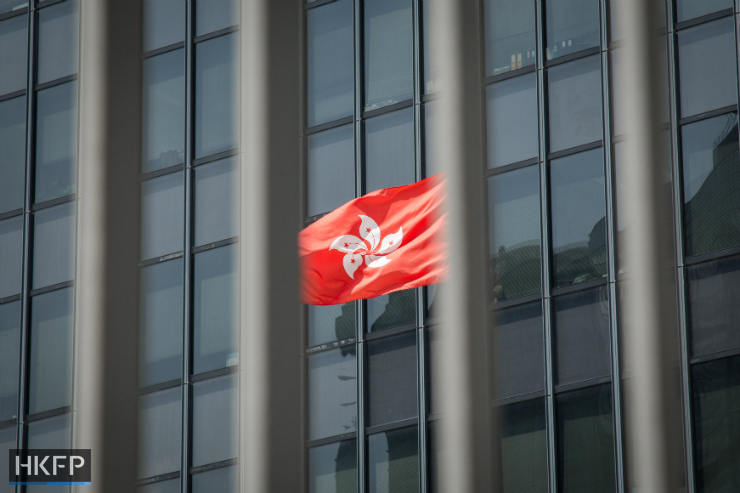By Minnie Wong, Howard Yang, and Vivienne Tsang
On a December night in 2006, a slight woman wearing a thick woollen jacket stands on a step ladder and addresses a crowd gathered at a candlelit vigil at the site of the old Star Ferry terminal in Central. She rebukes the government for demolishing the pier without consulting the public and, at one point in her speech, the crowd becomes solemn as some intone the “dong, dong, dong, dong” sound of the bell from the once iconic clock tower.

The last ferry had sailed from the pier less than a month before and some hours later, police would arrest 13 protesters who tried to retake the terminal building.
Ho Loy, a cultural worker who is now 50, led the campaign to save the historic pier which marked the beginning of a wave of local consciousness (本土意識) that informed a series of social movements, most notably the campaigns to save Queen’s Pier, Wan Chai’s Lee Tung Street and the anti Guangzhou-Hong Kong high-speed rail movement.
Although localism seems to be a new phenomenon in Hong Kong, localist currents are not new. Professor Law Wing-sang of Lingnan University traces its first wave to the early 1970s, as a conceptual term expressing the affection for Hong Kong culture and values by those born and raised in the city.
Law says the second wave arose during the transitional years, when Hong Kong’s future handover to Chinese sovereignty was being discussed and a “sense of crisis” emerged as Hong Kong people sought to protect their economic and political systems and way of life.

The third wave of localism started after the handover with the social movements, led for the most part by the so-called post-’80s generation activists, sounding its arrival. The localism espoused by these activists focused on the need to preserve Hong Kong’s heritage, to acknowledge the real historical experience of all Hongkongers, especially the grassroots and to protect its culture and values. In that sense, it promoted the sense of a unique Hong Kong identity. The localism of that time also questioned the central narrative of Hong Kong as an economic city, driven by development and commerce.
It is only in more recent years that it has become characterised by a more political sense of segregation between Hong Kong and China, leading to the rise of localist groups calling for Hong Kong independence and national self-determination.
Some say the protests against the Guangzhou-Hong Kong high-speed railway in 2010 was the turning point, while others think it was Beijing’s rejection on August 31, 2014 of a free and open nomination process for election of the Chief Executive by universal suffrage.
After the demolition of the Central Star Ferry terminus, Ho Loy formed a group called Local Action (本土行動) which played a key role in the campaign to save the nearby Queen’s Pier in 2007. The members were mostly cultural workers, artists, academics and activists, and counted Eddie Chu Hoi-dick among them. The activists took a creative but peaceful approach to protesting, staging cultural performances, sit-ins and occupations and going on hunger-strike.

Ho recalls it was a time full of possibilities. “We called it [the group] Local Action because we couldn’t think of a framework,” says Ho.
Although Ho says the organisation was rather loose and unfocused, she thinks it was also more diverse and open-minded compared with the localism of today.
“People possess a narrower imagination towards it now, they are less open to possibilities.” She finds it hard to engage with the concept of localism that emphasises nationalism and independence.
“I prefer the idea of self-determination, which refers to my value, an inner value,” she says.
Lingnan University’s Law Wing-sang says the massive July 1 protest of 2003, the Star Ferry and Queen’s Pier campaigns and the anti high-speed rail movement are significant incidents in which localism was a response to Hong Kong people’s sense of insecurity.
Law thinks the escalation in Hong Kong-Mainland conflicts since 2011 – such as the competition for maternity ward beds and infant milk powder and the Dolce & Gabbana incident where a store prevented locals from taking pictures but allowed mainland tourists to do so – gave rise to a new conception of localism. He says this version is very political, with a stronger idea of nationalism and the pursuit of independence. Its supporters demand a fundamental change in the political system and different methods to achieve that goal.
“They evaluate the previous ideologies of localism as immature… They worked to no avail,” Law says.

He explains that current mainstream localist thought is a strong rebound from the previous expression of localism. And he attributes the backlash to a conflict in values and ideology. The earlier proponents of localism or local consciousness did not want to touch on ethnic issues and embraced universal values. In contrast, people now say localism is about segregation both from the Mainland and Mainlanders and they will use violent and even illegal means to resist power.
“[The conflict] creates the split of right-wingers and left-wingers,” says Law.
Chan King-fai, a post-’80s activist and critic, was a core member of Local Action who participated in the battle to conserve Star Ferry Pier and Queen’s Pier. During the campaign, Chan directly hindered construction work by occupying Queen’s Pier. He also went on hunger strike for 118 hours.
Chan strongly disagrees with those who see the conservation movements as a kind of affection for colonisation. Although Queen’s Pier witnessed the arrival of most British governors, Chan says “there was only one day for colonists to land on the piers, for the rest of the 364 days [the piers] were used by locals.”
Chan remembers meeting young people who worked in Central and took their lunch boxes to eat at the pier because they could not afford the expensive restaurants. He adds the piers were important public spaces where the elderly and homeless people spent their time.
Today, Chan is often criticised for being left wing and attacked as a “left plastic” whose adherence to “peaceful, rational” protest methods are a form of defeatism that has let Hongkongers down. He says conflict now permeates our society.
“We lose patience even with our own people [Hongkongers],” he says. He recalls that during the occupation of Queen’s Pier, workers who relied on the construction work to make a meagre living opposed their movement. Chan reasoned and tried to negotiate with the workers because “we should not make them our enemies,” he says.
To Chan, the core value of localism is to protect the oppressed classes, the residents in old districts and hawkers, and, overall, to promote a more equal society.
“I think this [life of the oppressed class] is actually the common life experience of the majority of Hong Kong people,” he says and he regrets the change of focus in localism which he thinks ignores the disadvantaged and their needs.

Unlike Chan, Chen Ho-lok, a former executive committee member of the Land Justice League activist group, says he did not have a concrete idea of what localism was when he took part in the anti high-speed rail movement when he was just 22.
“Actually I was influenced by a soprano in the choir who was often absent,” says Chen, who was also a member of the Chinese University of Hong Kong Chorus. After seeing her distributing leaflets against the high-speed railway, Chen decided to help her.
Chen says he used to feel detached from Hong Kong. “Every time I watched the fireworks display, I did not recognise Hong Kong as somewhere I was familiar with,” says Chen.
However, he established a connection to the city after the Satyagraha walk in 2010. It was a slow walk across five districts, from Sheung Shui to the Legislative Council building, to protest against the Guangzhou-Hong Kong high-speed rail link. It “awakened” Chen and established his connection to his city. He gave up on his idea of studying or working overseas in order to concentrate on helping to cultivate civil society in Hong Kong.
Looking back, Chen reflects that the movement was made up of a loose group of individuals. He remembers 10,000 people surrounded the Legislative Council building in January 2010 after the legislature passed a HK$66.9 billion budget for the railway project.
A meeting was held afterwards to review the whole movement. The meeting of mainly post-’80s activists, descended into a disagreement between those on the right and left. Fellow travellers became enemies. One accusation was that protest leaders invited failure by continually de-escalating the protest when emotions were running high and that their methods were not militant enough.
“It broke many partnerships, made people disheartened and they could not collaborate with each other any more,” says Chen.
For Wong Wai-kwok, associate professor of the Department of Government and International Studies at Hong Kong Baptist University, this line of argument has become commonplace.
“People don’t discuss matters, they will ask whether you are a pan-democrat or if you will betray Hong Kong.” Wong says these kinds of discussion are almost personal attacks.
He believes there is neither a framework nor limits set for localism, which makes it an abstract concept to today’s youngsters.
“Students may not support certain ideologies of localism, as they are too abstract, but they will support political organisations such as Youngspiration and the Hong Kong National Party,” says Wong.
Wong observes that young people seem to place their hopes on political stars from the localist groups with little questioning. He notes that having invested their trust in them, some students “don’t dare to oppose these groups” even after seeing them attacking each other in this year’s Legislative Council election.

But while Wong sees changes in localism, Brian Fong Chi-hang, an associate professor of the Academy of Hong Kong Studies at the Education University of Hong Kong, sees a vital and unchanged element in localism – the uniqueness of Hong Kong identity. Fong cites the example of values such as liberty, the rule of law and integrity which distinguish Hong Kong from China.
“Hong Kong identity is always facing a mirror, which is China. All our values are relative to that of China. For instance we speak Cantonese while they speak Putonghua,” Fong says. He believes the term localism reflects, to a certain extent, the Hong Kong-Mainland segregation.
Fong sees the National People’s Congress Standing Committee announcement on August 31, 2014 which ended Hong Kong’s hopes for a free and open election of the Chief Executive as a landmark that showed that “Beijing’s power over Hong Kong is explicit, direct and violent to a certain extent … leading to the strongest rebound in the ideology of localism.”
Fong notes that Beijing’s policy on Hong Kong was relatively hands-off when Tung Chee-hwa, the first Chief Executive of Hong Kong was in office. This changed after the 2003 July protest and intervention has been more intense since 2014.
Localism is just a defensive response, Fong says. “Localism transforms into a backlash, a confrontational emotion against the Chinese government’s interference … People say Beijing has lost a generation of [Hong Kong] people, but I think she has lost generations.”
